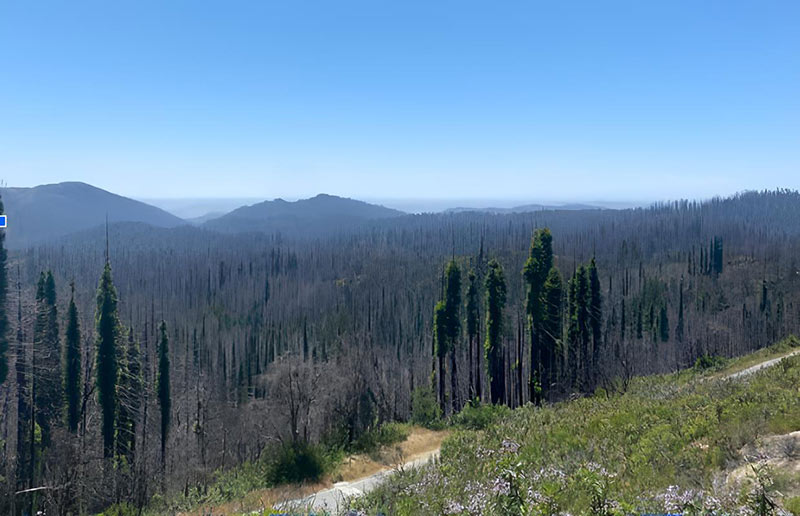
Should I Stay or Should I Go?
For Mike Holton, it was love at first sight.Boulder Creek was supposed to be just one stop on his road trip with his daughter. As they drove Highway 9’s winding roads, the town that appeared before him called to him in a way he had never felt before.Like so many others, Holton immediately felt captivated by this quaint, rustic town of wild west-esque wooden buildings nestled within mystic redwood forests.
That day, he was overwhelmed as he breathed in the natural splendor and decided there and then to make it his home.“It’s just heaven on earth … a majesty of all of your senses: the visuals … of the mountains and the huge redwoods … the fragrance in the air … the sound of the rushing water,” he said. “You put it all together and it’s a magic kingdom … [But, I’ve] realized that I can’t stay.”After enduring two and a half years of repeated catastrophes and delayed recoveries, Holton believes this magic kingdom is collapsing around him
Holton is “very worried… the infrastructure in the San Lorenzo Valley was not prepared for either one of those disasters… and we’re not even close to being prepared [for future disasters].”Between the 2020 CZU Fire and 2023’s winter of extreme storms, much of the San Lorenzo Valley lies in ruin, littered with the reminisces of burned houses, collapsed roads, downed trees and broken infrastructure that has routinely shut down the mountain.
Living in this continual disaster zone with little reprieve has forced residents like Holton to question the security, safety and longevity of the rugged refuge they once could never imagine leaving.
Some residents long to return to their destroyed houses but have been obstructed by local policies impeding their ability to rebuild. Others can no longer bear to live in this fragile region, vulnerable to cycles of climate change catastrophes like wildfires, droughts, mega-storms and landslides.Those that remain are watching their neighbors begin to dissipate, pushed away by the devastation brought by climate change.
In total, the San Lorenzo Valley’s population has reduced by -2 percent in the last three years. This exceeds any other region in the county. Smaller communities on the mountain like Boulder Creek have seen their population transition from increasing by 2.5% the year before the pandemic to decreasing by -3% in the last three years as more and more of the community leaves with every sequential disaster.
When Catastrophe Strikes
(Again and Again)
This population decline was catalyzed when lightning struck the mountain.“We always said Big Basin [State Park] would take the perfect storm to burn,” said Gabe Vega, the Boulder Creek Volunteer Fire Department’s Battalion Chief. And that storm rolled in during the sweltering early hours of August 16th, 2020.
The CZU Fire was started by a deadly concoction of drought, heatwaves and freak summer thunderstorms that, in total, started 650 wildfires across Northern California.
“The fire was getting so big” when Vega and other firefighters arrived, “that this was defensive: we needed to start evacuating structures and evacuating communities and just try to save houses as it was coming down the mountain towards the town of Boulder Creek and towards the San Lorenzo Valley.”
As the fire rapidly spread, about 60,000 people, or 1 in 5 Santa Cruz County residents, were told to immediately evacuate their homes as smoke began to fill the sky and ash rained down upon the San Lorenzo Valley.
The CZU Fire became the most destructive fire in Santa Cruz County in over a century, consuming over 86,509 acres of picturesque redwood forests, destroying 1,490 buildings, damaging the region’s already weak infrastructure and eroding the mountain’s physical stability
This ecological wreckage created the perfect conditions for maximum storm devastation, producing destabilized hillsides ready to slide and dying trees ready to fall when unrelenting rain and wind beat upon them this winter.
Beginning with New Year’s Eve’s extended bomb cyclone and continuing through March, this winter brought one storm after another, drenching the landscape, engorging the rivers and even coating the mountain in snow.
David Scruggs, a long-time Boulder Creek resident and previous volunteer firefighter, and his neighbors experienced “heavy, extensive damage from the windstorms” that “hit harder up here than it did anywhere else … in Santa Cruz County.”The topography of the Santa Cruz mountains inherently intensifies storms, meaning the area can experience up to four times the rainfall than the rest of the Bay Area. With climate change extremifying these weather patterns, residents have struggled to survive this winter of destructive falling trees, extended power outages and washed-out roads cutting them off from civilization.Marc Koenig, a teacher at Boulder Creek Elementary School, saw “families that walked … through mudslides to come and pick up their kids … through pretty dangerous areas.” Few completely escaped this compounding ruin, leaving the majority of residents with the monumental feat of recovering all that was lost.
Tearing up the Roots
For Christopher Bradford and his family, their home tucked away in the redwoods was the center of their world, ‘where everything else sprouts from. [It was] the foundation [the fire] took away … it was a very hard period for my family and for many families.”
However, losing their house during the CZU fire was just the beginning of their hardships.“ I found [the county’s] response to the disaster was another disaster in itself,” Bradford says. “Look at the rebuild numbers, the data is quite clear.”
Only 3.5% of the 911 homes lost in the CZU fire have been rebuilt. For almost three years, Bradford and other fire victims have been unable to rebuild because of convoluted, expensive county permitting practices.
Bradford has experienced “a huge amount of personal difficulty because of the county’s response … they wouldn’t let us rebuild right away.” Between the high cost of required pre-clearance consultations and processing delays “pushing us back more than a year, our costs for my private rebuild went from about $800,000 to a little over a million dollars.”
These are fees and delays that many low-income fire victims cannot afford. Part of Bradford’s frustration is because the county initially “told individuals who lost their homes to the fire that they wouldn’t be treated like new-builds,” which are held to “extremely onerous [building] code regulations.”
Dave Reid, the Director of Santa Cruz County’s Office of Response, Recovery, and Resilience,which was created post-CZU fires to improve community emergency response, admits that while the county tried to streamline the permitting process, including loosening geotechnical requirements and subsidizing some permit fees, they haven’t “helped as many people as we had hoped.”
While Reid empathizes with the struggles of those whose hearts are ‘connected to the valley … [and their] community … and really want to get back,” he maintains that these delays are caused by either outside barriers, including consultant shortages, or the complexities of building in the San Lorenzo Valley.“We live in a very geologically diverse and complex community … [living] next to the San Andreas and Zyanti faults’’ means the county needs stricter permitting codes to “keep people safe.”
However, Bradford says the county has failed to protect and provide for fire victims during their time of crisis, motivating him to run as the next 5th District Supervisor in the 2024 county elections. “
They could have not treated us like new-builds. They could have taken care of us, and they didn’t. And now there’s a lot of my neighbors who are never going to make it home again, and that breaks my heart.”
Leaving the Danger Zone
Living in Boulder Creek for 39 years, Joanne Scruggs had never seen her husband scared. “We’ve never experienced a winter like this … two trees fell right in front of him … He’d never before been scared living here … but he was scared.”The Scruggs’ atypical experience mirrors those of residents across the valley: climate change is making the weather more extreme, violent, and, for the first time, terrifying. Climate change has brought year-round danger – forest fires and storms, droughts and floods – that promise to continue raising the cost of insurance, wearing down infrastructure and threatening residents’ lives.
While the county has plans to “build resilience” against future disasters, Reid says the county doesn’t want to “incentivize people building in … hazard areas,” instead encouraging mountain communities to “move into an urban environment” that could more easily protect and “meet their lifes’ needs.”
While Reid recognizes “there’s always people that want to live in the mountains,” he thinks the effects of climate change will force many “to reconsider where they live.”
After enduring storm after storm, Holton realized he “was just going to be constantly apprehensive” of what disaster climate change could bring next.“I just couldn’t do this over and over again.”Tina Davey, the host of KBCZ, Boulder Creek’s community radio station, says that these continued ecological trials have scared all residents.
Residents, like Davey, lucky enough to still have their homes, watch “the rebuilding process, the permitting process … the hoops people have had to go through” and worry, “when is it gonna be my turn?”After experiencing “the sheer terror of” the fire and storms, Davey says “a lot of people just were done. They didn’t lose their house but … [there were] too many close calls. They just couldn’t do it anymore.”
Home, Bittersweet Home
Yet, despite these grave climate realities, leaving has never been an option for some. The mountain and the communities within it are their home.“These challenges have definitely changed the way we think about living here,” said resident James Mosher. But, “we are not contemplating moving. It’s home.”
Instead, they intend to “balance being prepared for the next set of disasters” and simply “appreciating the beauty we have each day.”Davey knows some individuals who, despite watching a falling tree destroy their half-rebuilt house that the CZU fire originally burned, are still “gonna stay … gonna keep doing it.” Davey herself could not see herself ever leaving “the sheer beauty of the nature that’s here and the community that’s here.”
Still, despite the area’s beautiful landscape and caring community, Holton believes “more and more of the residents will make the same decision I made.”His adoration for the natural majesty he discovered in Boulder Creek will never truly disappear. But climate change has eclipsed its allure.“It’s really tough to leave … I’m going to miss it … so much … But the decision has been made and we gotta go.”
Writer Elise A. Cline is a political science major and journalism and disability minor at U.C. Berkeley.






